Gate 1 Itinerary of Egypt

I took a Gate1 tour to Egypt, starting out from Los Angeles on Wednesday, January 19, 2011, and arriving in Cairo on Thursday, January 20, after a change of planes in Frankfurt. My seatmates from Los Angeles to Frankfurt were a Sikh couple from Bakersfield, CA, who both slept through some very long and rough turbulence over the North Atlantic, while I was holding tightly onto the seat rests. From Frankfurt to Cairo, my seatmates were two young American college students who were traveling to Egypt to study Arabic in Alexandria. The tour itinerary: meet tour group in Cairo; fly the next day to Aswan; cruise to Luxor with a stops in Kom Ombo and Edfu; fly from Luxor back to Cairo on Monday, January 24; visit the Egyptian Museum on Tuesday, January 25 (first day of protests in Cairo and elsewhere); excursion to Alexandria on Wednesday, January 26 (second day of protests in Alexandria, Cairo, and elsewhere); and happily fly home to Los Angeles from Cairo on Thursday, January 27.

Gate 1 Itinerary of Egypt
Lobby of Iberotel Cairo Hotel & Casino
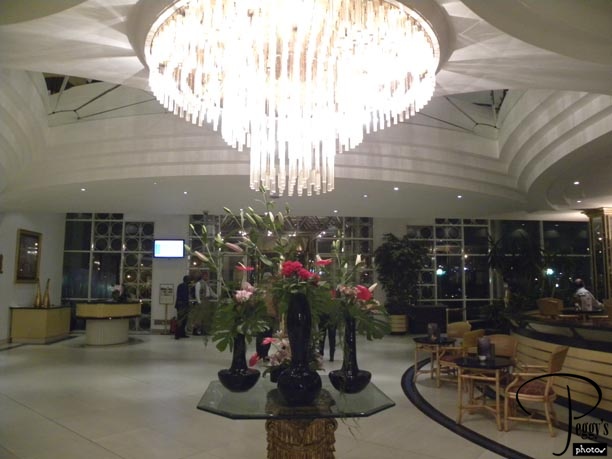
I was met at the Cairo Airport by a Gate 1 representative after purchasing an Egyptian tourist visa for $15 from an airport bank and going through immigration. The new Cairo airport was built two years ago and it is spectacular. When I flew into Casablanca in October, almost everyone at the airport was in some kind of Islamic dress. Here in Cairo, almost everyone was in business suits. Egypt was looking like a very sophisticated country. We didn’t leave for the hotel for about an hour because a couple on my tour was supposed to be on my plane from Frankfurt. We found out later that their flight from San Francisco to Frankfurt was cancelled and so Lutfthansa had flown them first to Rome, then to Istanbul, and finally to Cairo. They landed in Cairo the following day. All I wanted to do when I got to my hotel was to have something to eat and then to sleep. My tour guide, Amro, was at the hotel to meet me with the depressing (very depressing) news that wakeup time for tomorrow was 2:30 a.m. and to be ready to leave at 3:15 a.m. for our flight to Aswan. At first, I thought he was kidding.

Lobby of Iberotel Cairo Hotel & Casino
Doorman at Iberotel Cairo

I did get something to eat and then went in search of the business center. I was told that it was on the first floor. I went down to the first floor and was then told the business center was on the fourth floor. I asked then why was I told it was on the first floor. Answer: The business center is on the first floor. A bit more going around on this and I left to go to the fourth floor and found the business center. I knew that this was going to be an interesting trip. I think I figured it out: the hotel has four floors. The top floor is the fourth floor, which somehow makes it the first floor. Anyway, I couldn’t log on to Earthlink or CNN and gave up and texted home that I had arrived.

Doorman at Iberotel Cairo
Aswan International Airport
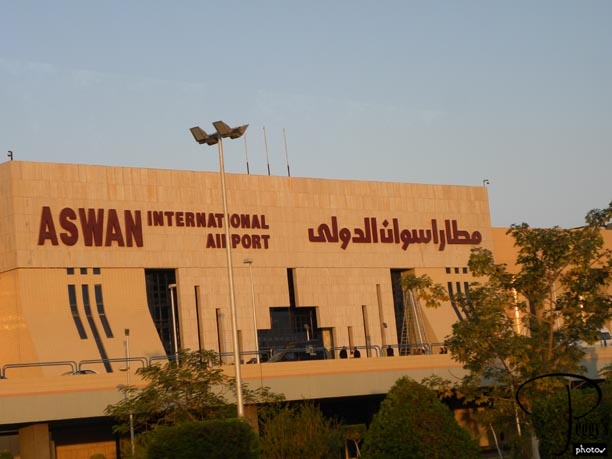
Gate 1 provided us with coffee to wake us up and I met some of my tourmates. One group of 11 had joined our tour after having spent 6 days in Israel (they arrived after 11:30 p.m. last night). There were about 42 people on our tour, all Americans except for a mother/son from Brazil who hadn’t lived in Brazil for a long time. There were four other women traveling on their own besides me. Our hotel provided us with breakfast boxes to eat on the bus or plane. Amro told us that tour groups are at the mercy of Egypt Air as to what time they will fly within Egypt—hence, our early flight was their idea.
We are starting our tour of Egypt in southern Egypt, which, however, is called Upper Egypt. The northern part of Egypt is called Lower Egypt. This is because the Nile River flows from south to north.

Aswan International Airport
Temple of Kalabsha
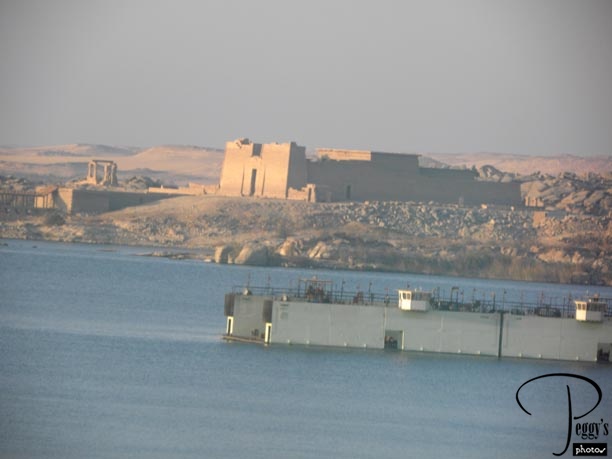
Our first stop in Aswan was to view the Aswan High Dam. Before entering the dam area, we picked up our armed tourist police escort. Amro told us that the U.S. Embassy had requested these escorts for American visitors to Egypt. I had no prior knowledge of this and it surprised me. According to Amro, visitors from other English–speaking countries also get these escorts, but not the French or the Germans.
We passed by the Temple of Kalabsha, on Lake Nassar, built by Emperor Augustus in the 1st century AD and dedicated to the fertility god Marul. It was moved to its present location in 1970 when the building of the Aswan High Dam flooded a number of monuments. What an unbelievable undertaking to move the ancient monuments.

Temple of Kalabsha
Close-up of the Temple of Kalabsha
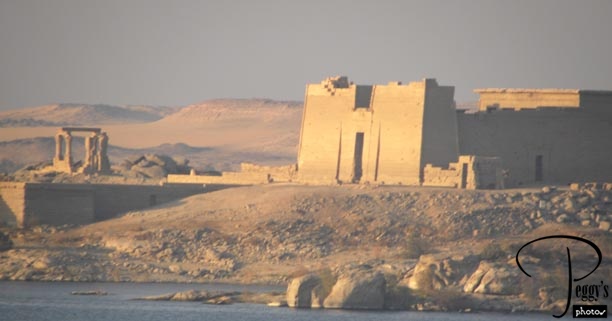

Close-up of the Temple of Kalabsha
Aswan High Dam Monument
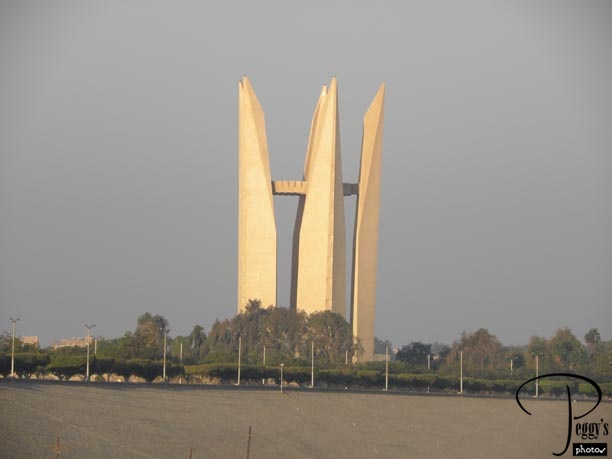
There are two dams at Aswan. The first, known just as the Aswan Dam, was built by the British between 1898 and 1902. It was, at that time, the largest dam in the world. However, it was not sufficient to control the Nile River, so the Aswan High Dam was built between 1960 and 1970 under the rule of Gamal Abdel Nassar (there is a commemorate lotus–shaped tower here—too hard to photograph—to the Soviet Union’s support of the dam). The building of the High Dam was very big international news at that time.

Aswan High Dam Monument
Aswan High Dam
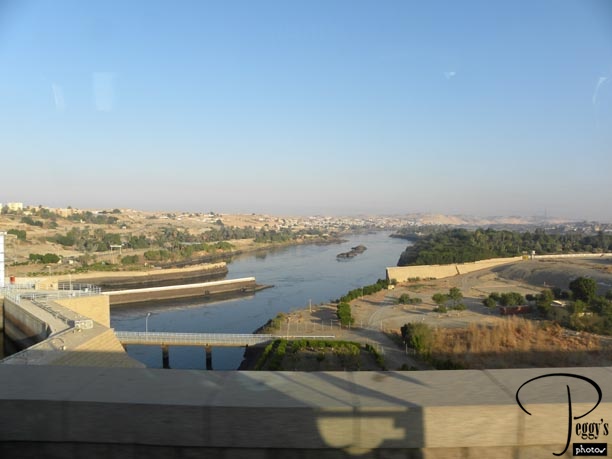
The Aswan High Dam is huge; it makes our Hoover Dam look like a baby. The dam was built to regulate the flow of the Nile River and so to increase cultivated land in Egypt. The dam also created Lake Nassar, which is the world’s largest artificial lake. It is also the home of the only wild crocodiles in Egypt.

Aswan High Dam
Visitor’s X-ray Building
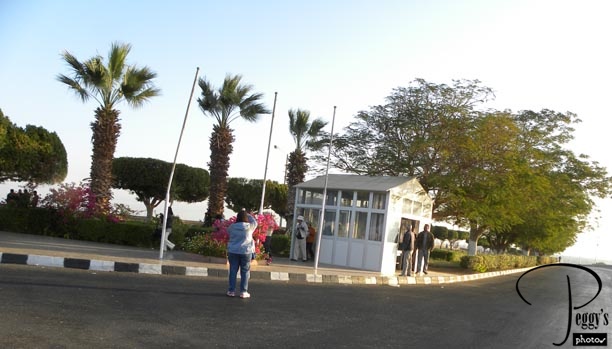
At almost every site that we visited in Egypt, we first had to walk through an X–ray, more like an airport metal detector. Any bags that you were carrying also had to go through a regular X–ray machine. And, of course, there were soldiers and/or policemen at all of these visitor welcomes.

Visitor’s X-ray Building
Welcome Sign
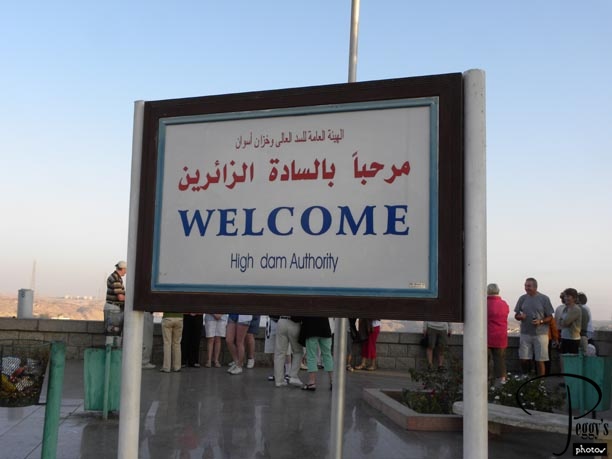

Welcome Sign
Explaining the Aswan High Dam
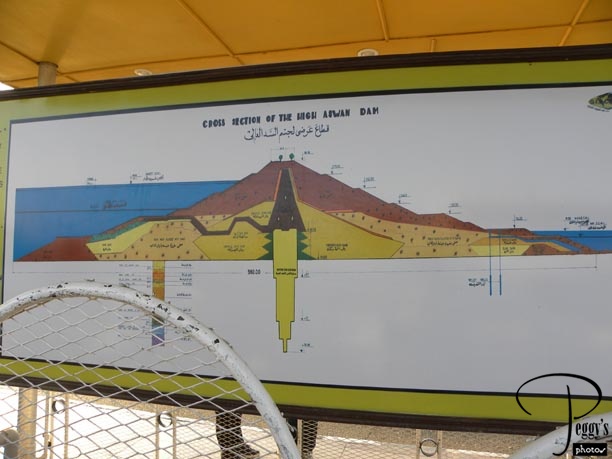
I imagine this sign make sense to someone with an engineering background. There was also another sign here. That seemed to be it for the Visitor’s Center, but maybe there was more that we didn’t get to see. No video or long–range zoom allowed here of the Aswan High Dam.

Explaining the Aswan High Dam
City of Aswan
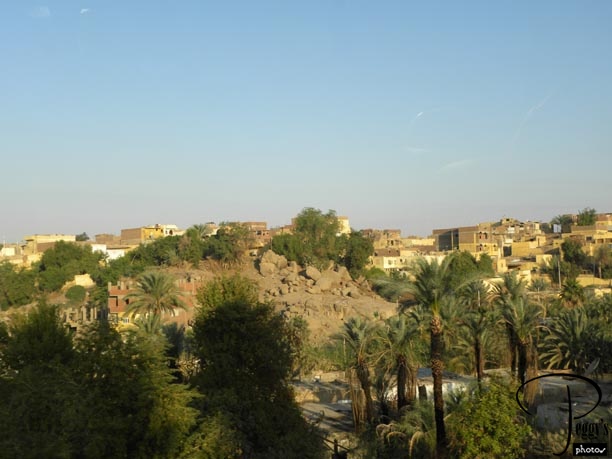
A view of the city of Aswan after leaving the Aswan High Dam. Aswan’s population is about 275,000.

City of Aswan
More of Aswan
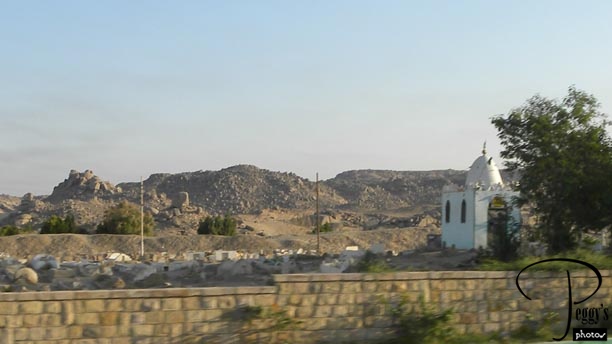

More of Aswan
Vendors Waiting to Pounce on the Hapless Tourists
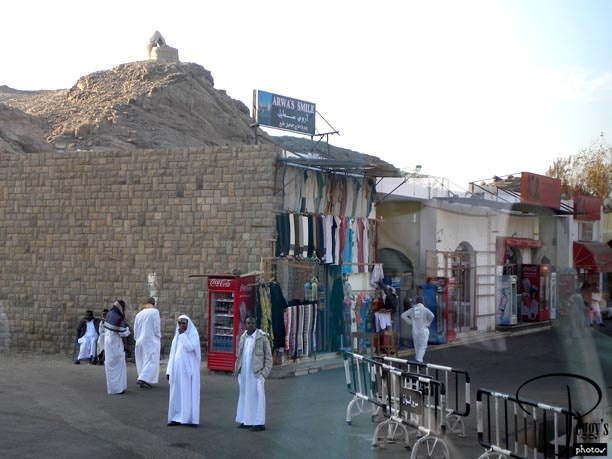
This was our first introduction to the Egyptian shopping gauntlet. Here are the vendors waiting to pounce on the tourists trying to get from the bus to the dock. Amro told us not to make eye contact with them and do not even say the word “no” when merchandise is thrust into your face. Just keep walking and quickly. The whole stupid thing about all this is that most tourists are quite eager shoppers, but most also like to “shop and stroll,” look leisurely at the merchandise, handle it, put it down, look at other merchandise, and then make a decision as whether to buy. Not the way it is done in Egypt. But if you actually do want to make a purchase, then you have to bargain down the price as the first price given is always many times what the item is worth or what you can buy it for in the end. Also, don’t tell a fellow tourist how much you finally paid for an item as they will then tell you that you paid too much as they had bought the same item for even less.

Vendors Waiting to Pounce on the Hapless Tourists
On the Way to Catch a Boat to Philae
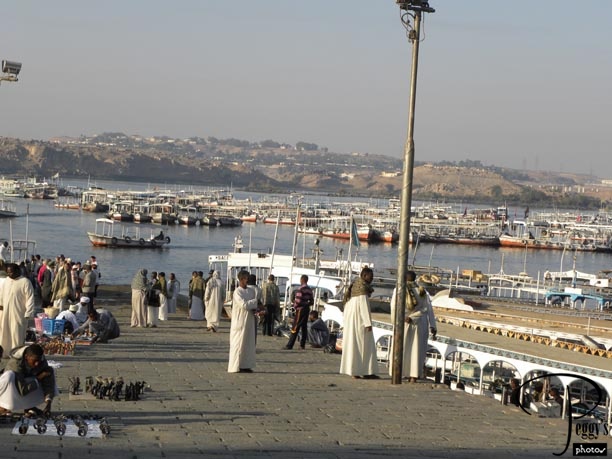
The men here are Nubians, from the area between Aswan in Egypt and Khartoum in Sudan. Some of the men wear scarves around their heads and shoulders. Notice the number of boats here to take the tourists to Philae.

On the Way to Catch a Boat to Philae
Things for Sale
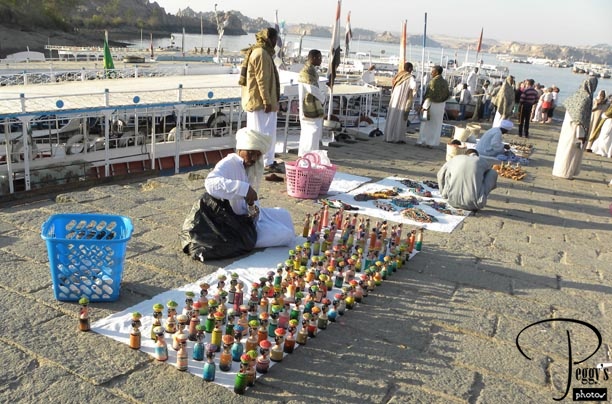
There were some interesting items for sale and most were for $1.00–$5.00 U.S. I had changed dollars into Egyptian pounds at the airport and didn’t know that I should have brought along a stack of $1.00 bills. In most places, it was easier to buy souvenirs in U.S. currency than in Egyptian pounds (about 5.8 Egyptian pounds per U.S. dollar).

Things for Sale
More for Sale
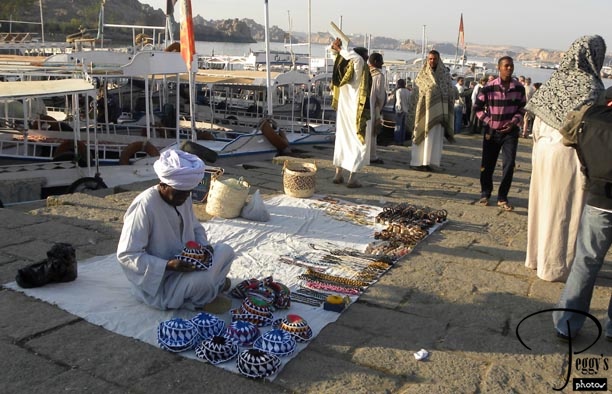

More for Sale
Getting onto Our Boat
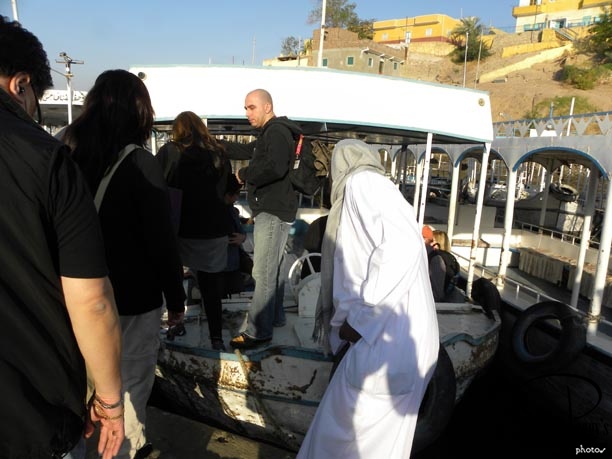

Getting onto Our Boat
Our Tourist Policeman
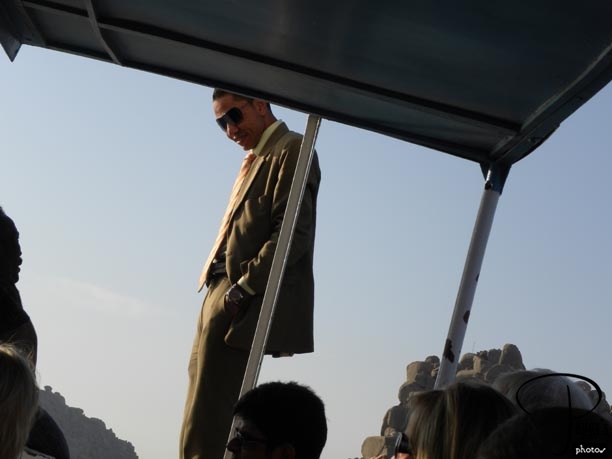
Our tourist policeman checking to see if we were all okay. Our tourist policemen were all nicely dressed in suits and brightly colored ties. This one seemed to be carrying quite an arsenal on his backside. Others had their guns hidden under their suit jackets.

Our Tourist Policeman
Man on Boat Blocking Our Boat
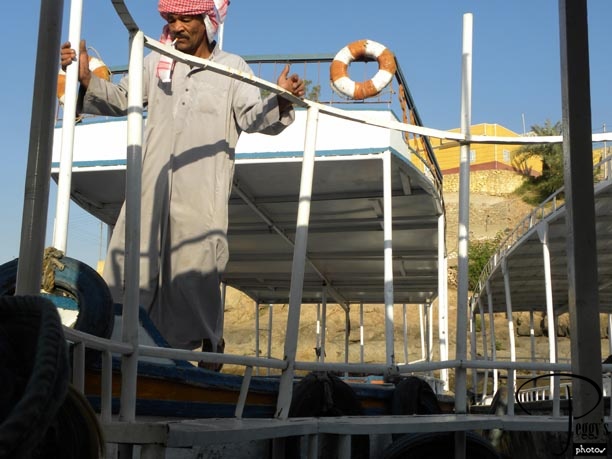
Our boat was reached from the dock, but there were two boats behind us that had to move for us to leave. Simple way this is done: Just push the other boats out of the way. The boats have tires on their sides so they don’t get scraped when this is done.

Man on Boat Blocking Our Boat
Starting the Motor
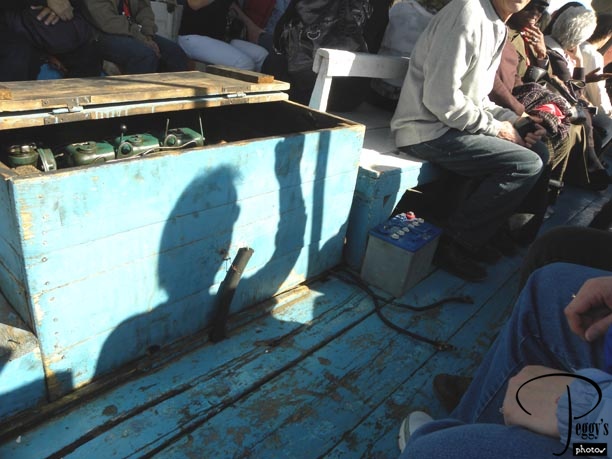
One of the boatmen would come to the back of the boat and hook up the battery and then start the boat’s motor

Starting the Motor
We Are Off
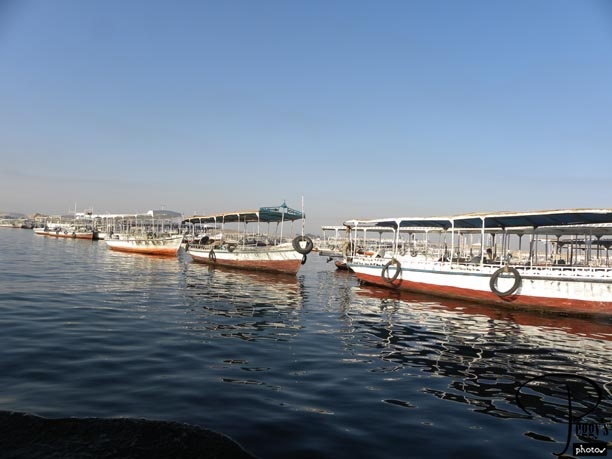

We Are Off
Houses Along the Shoreline
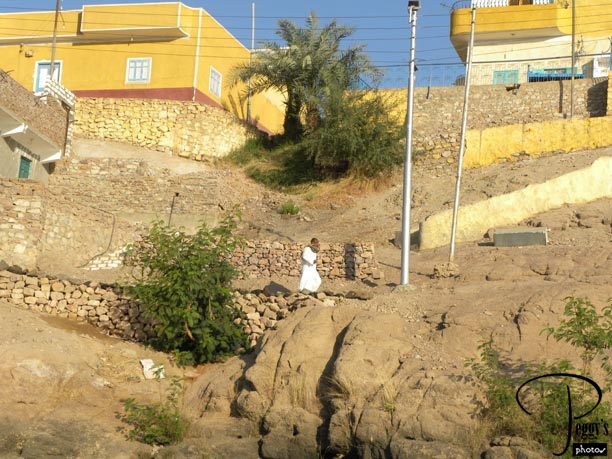
There were some very pretty houses here.

Houses Along the Shoreline
Close-up of One of the Houses
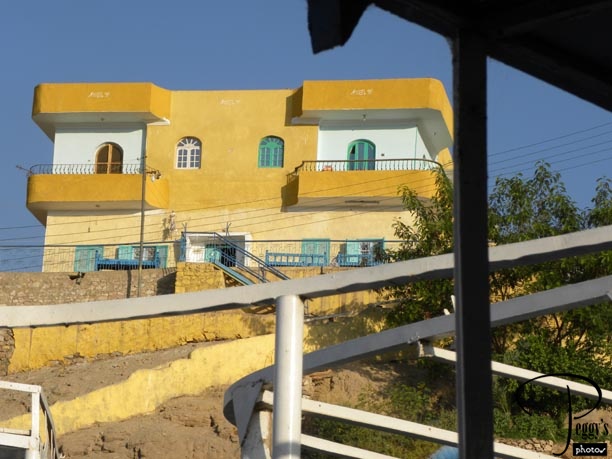

Close-up of One of the Houses
View of the Hillside Near the Pier
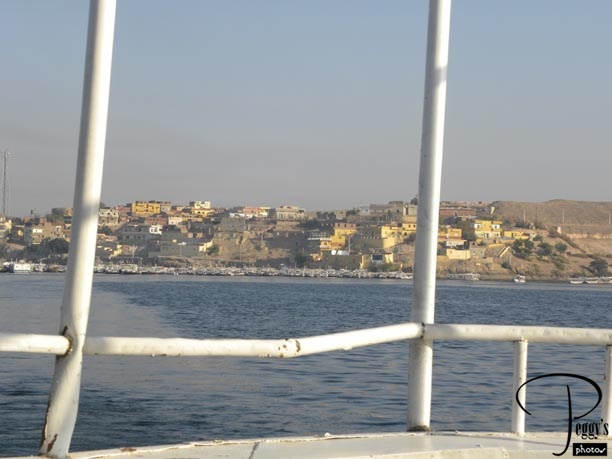

View of the Hillside Near the Pier
Many Rock Formations in the Water


Many Rock Formations in the Water
View of the Temple of Philae from the Water
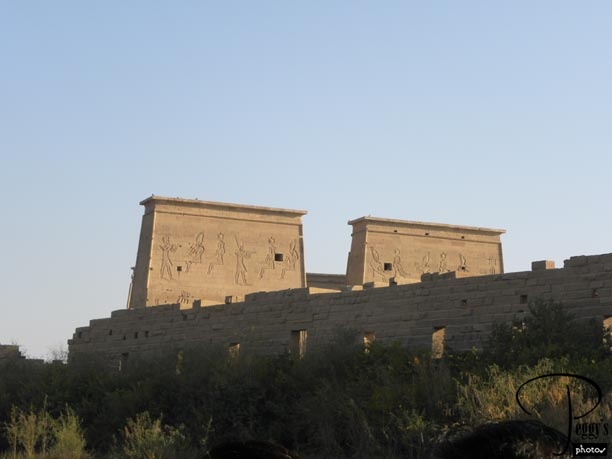
After the building of the first Aswan Dam, most of the temple on the island of Philae was submerged. When the Aswan High Dam was built, the monuments were relocated from Philae to the island of Agilika nearby. A monumental undertaking!
The Temple of Philae was dedicated to the goddess Isis. Its main buildings were begun by Ptolemy II (285–246 BC) and completed by Roman emperors about 800 years later. With the temple built in stages, the architecture is not only Egyptian but also Greco–Roman. The legend of Isis: Osiris, a mythical king, was killed by his brother Seth, who cut up his body and scattered it all over Egypt. Osiris’ wife, Isis, and her sister, Nephthys, picked up the pieces and put Osiris back together as the first Egyptian mummy. Isis used her magic to revive him and had a son, Horus, by him. Horus avenged his father. A cult formed around Isis, who also is credited with civilizing the world by introducing marriage and by teaching women domestic arts, and many pilgrims came to the Temple of Philae to honor her.

View of the Temple of Philae from the Water
My Tour Group and Tour Conductor with His Back Toward Us
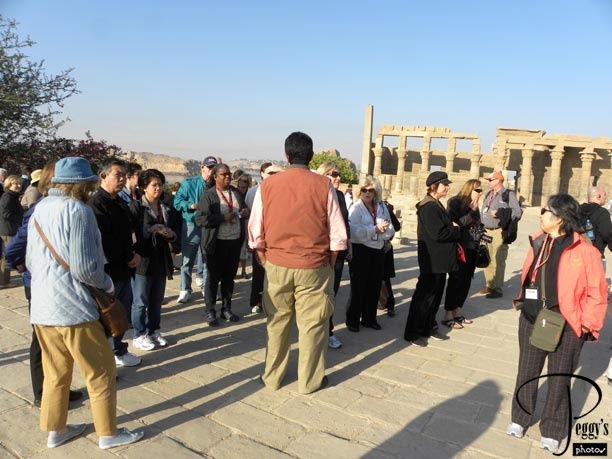
We were given Whispers to wear—similar to the audio boxes you are given at museums. However, Amro could talk to us through the Whispers. I like these as I tend to walk away from my tour guides to take photos when they are talking. With the Whispers, I could listen and shoot at the same time.

My Tour Group and Tour Conductor with His Back Toward Us
Our Tour Guide, Amro
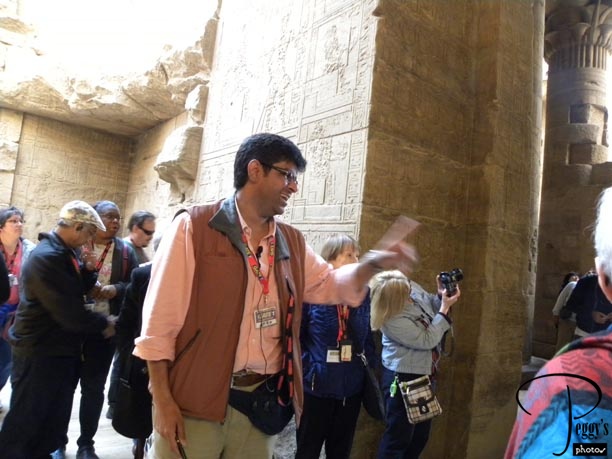
Amro’s real name is Amr, but he thought this was too hard for us to pronounce. But many of us had trouble with remembering the name Amro—I think some of us thought of Amway, something familiar, and then converted it to Amro. We all wore name tags, even Amro, which helped as well.

Our Tour Guide, Amro
And Another Photo of Amro
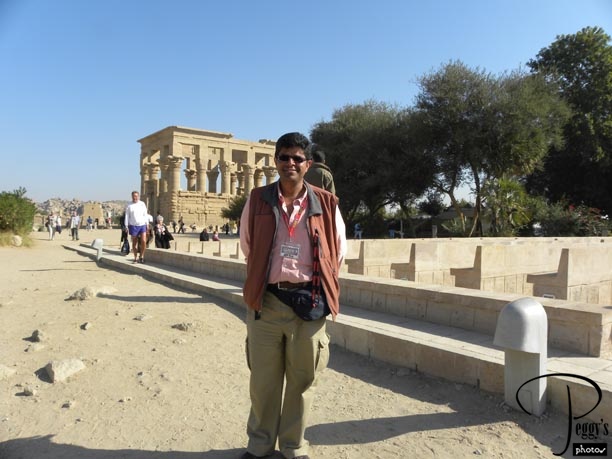
Amro was an excellent guide and very enthusiastic explaining ancient Egypt to us. He is actually an Egyptianologist, specializing, I believe, in the 26th Dynasty.

And Another Photo of Amro
The Temple of Philae
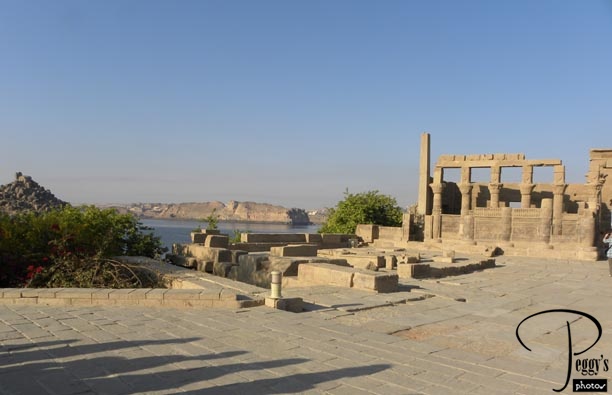
First structure of the temple after debarking from the boat. This is the Kiosk or Hall of Nectanebo II (380–362 BC) from the 30th Dynasty and is the oldest building of the complex.

The Temple of Philae
Close-up of the Kiosk of Nectanebo II
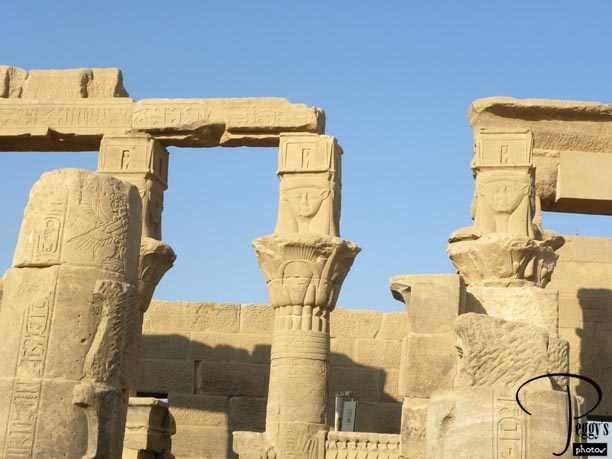

Close-up of the Kiosk of Nectanebo II
The Temple of Philae
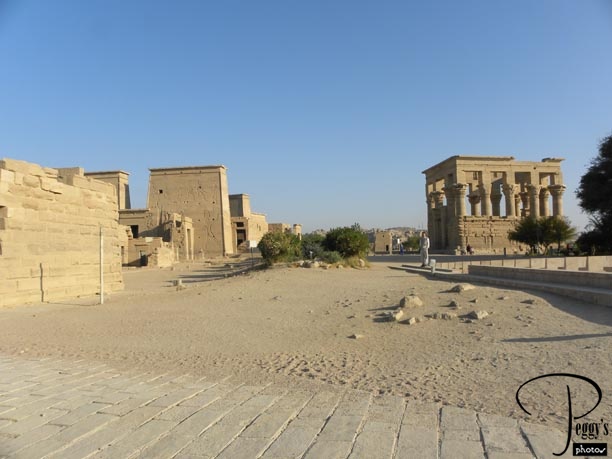
On the right is Trajan’s Kiosk, and on the left, the main temple buildings. The first thing I noticed was how immense there structures are. The second thing was in how great shape the buildings are in, especially considering their age and also that they were for a time submerged. All these buildings were originally painted, but except for occasional small patches, all the paint is gone. If you want to see an artist’s rendition of how the Temple of Philae originally looked, go to www.eyelid.co.uk/philae1.htm.

The Temple of Philae
The Temple of Philae
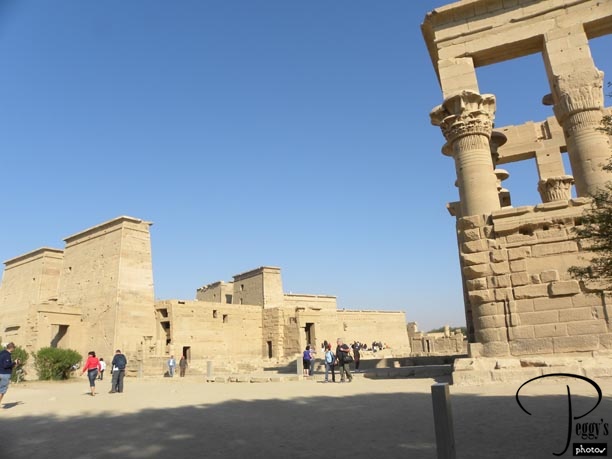
View showing both the first and second pylons of the main temple. Each pylon had two towers.

The Temple of Philae
The Outer Courtyard
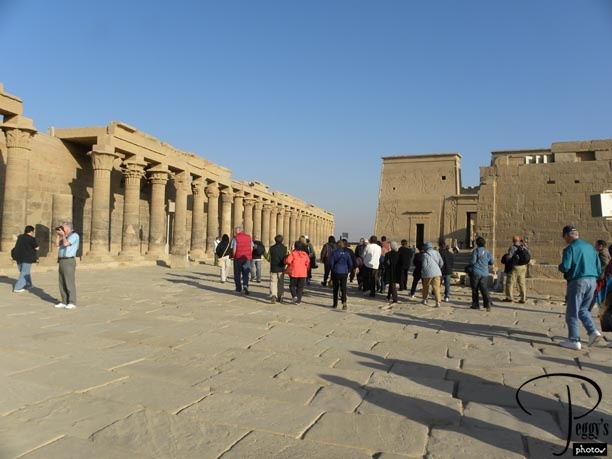

The Outer Courtyard
Two Rows of Columns
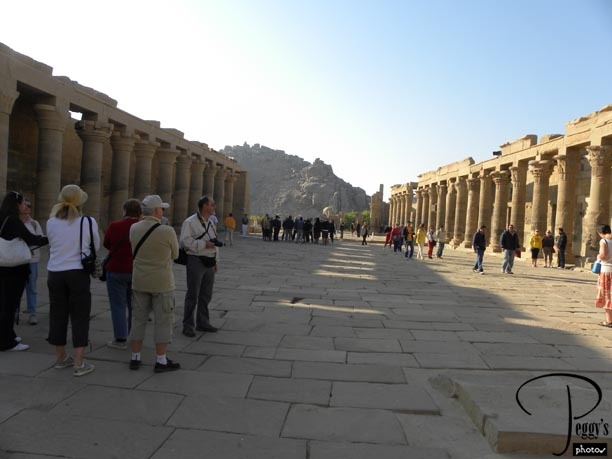
Looking backward at the columns on both sides of the outer courtyard.

Two Rows of Columns
Inside the Columnade
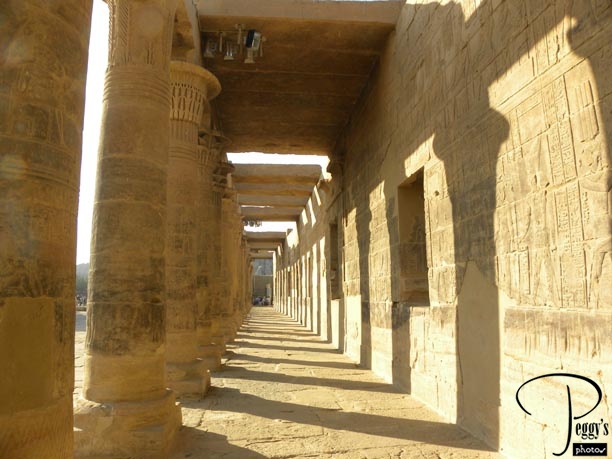
Inside the columnade on the right, showing walls completely covered with Egyptian figures and hieroglyphics.

Inside the Columnade
Close-up of Egyptian Figures and Hieroglyphics

Egyptianologists and other people who study Ancient Egypt are able to recognize the figures portrayed and to read the hieroglyphics due to the discovery of the Rosetta Stone by Napoleon’s army, which contained text in three scripts: hieroglyphics, demotic, and Greek. Before you travel to Egypt, if you study the hieroglyphics, you’ll be able to recognize some of the writings.

Close-up of Egyptian Figures and Hieroglyphics
Main Temple Dedicated to the Goddess Isis
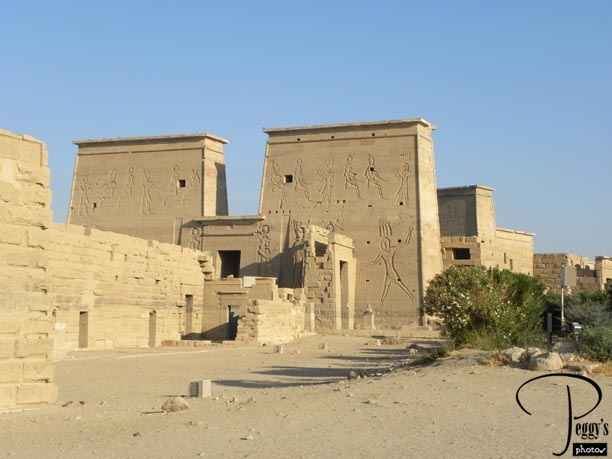
The main temple dedicated to the goddess Isis was built by Ptolemy XI (80 BC). In the foreground are the Temple of Aryhesnefer (also known as Anhur, warrior and hunter god) and behind it the Chapels of Mandulis (Nubian sun god) and Imhotep (chancellor to the pharaohs and high priest of the sun god Ra).

Main Temple Dedicated to the Goddess Isis
First Pylon
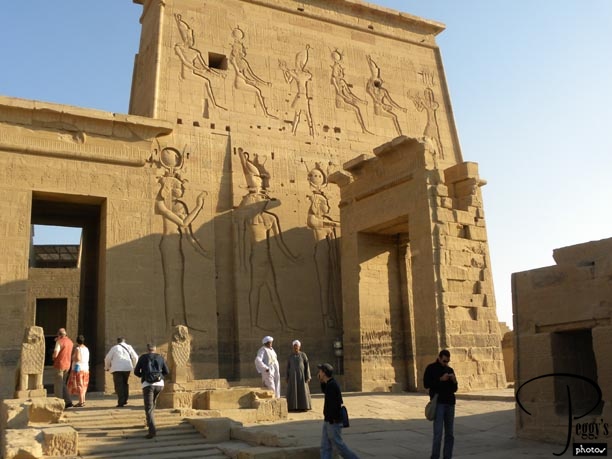
The figures depict the birth of the god Horus by his mother Isis.

First Pylon
Close-up
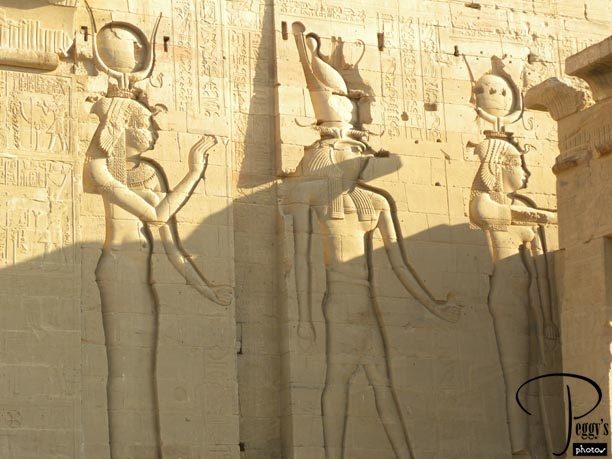

Close-up
First Pylon

Scenes of Ptolemy XII massacreing his enemies.

First Pylon
The Gate to the Second Pylon
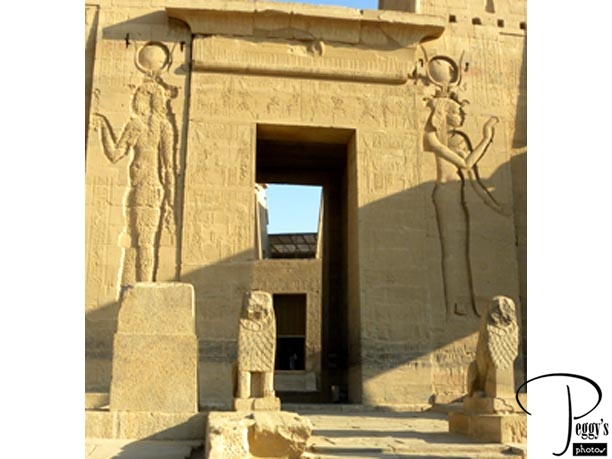

The Gate to the Second Pylon
Walking Through the Gate to the Inner Courtyard


Walking Through the Gate to the Inner Courtyard
Local Color
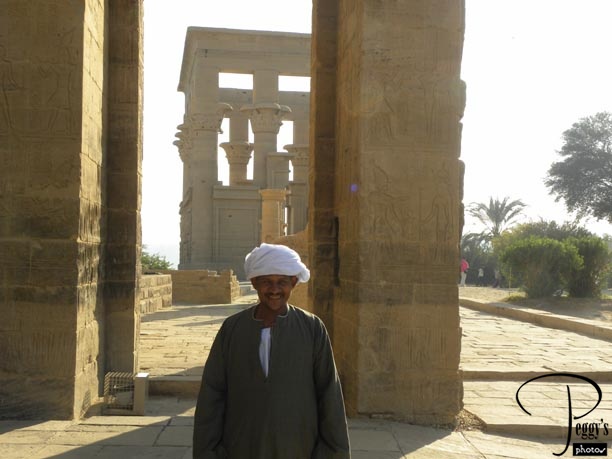
I took this photo right before walking through the gate. Men in this type of clothing walk around the temple just in case you want to take a photo of them—of course, you pay them to pose (you do this in other countries, so this was no big deal for me). But here in Egypt, this is called baksheesh, which is a small tip for service (you know when you are expected to pay baksheesh when you see someone’s hand out of receive it). You pay baksheesh for toilet paper before you enter the bathroom (even if there is already toilet paper in it), for help up questionable stairs, putting your luggage on the X–ray machines, etc., etc. There is always someone to help you and to collect baksheesh and you need to stay above the game to avoid paying it, as collecting it is a fine art in Egypt.

Local Color
The Inner Courtyard
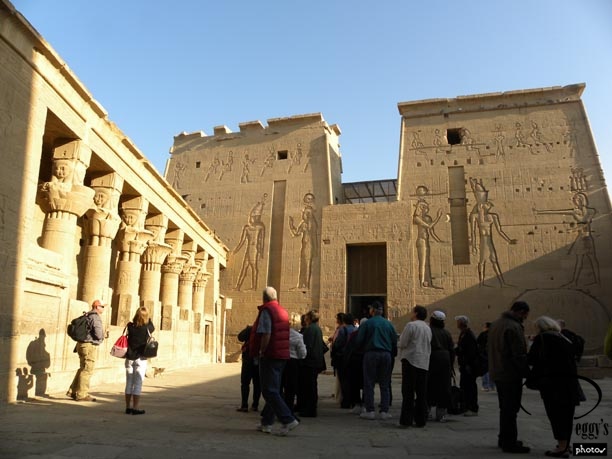
The inner courtyard before the second pylon. This is either the Hypostyle Hall or the Birth House. There are 10 columns on the left side.

The Inner Courtyard
Close-up of the Columns
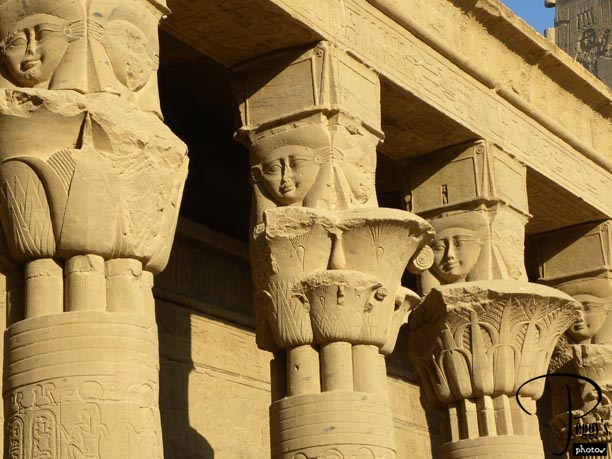

Close-up of the Columns
Inside the Second Pylon
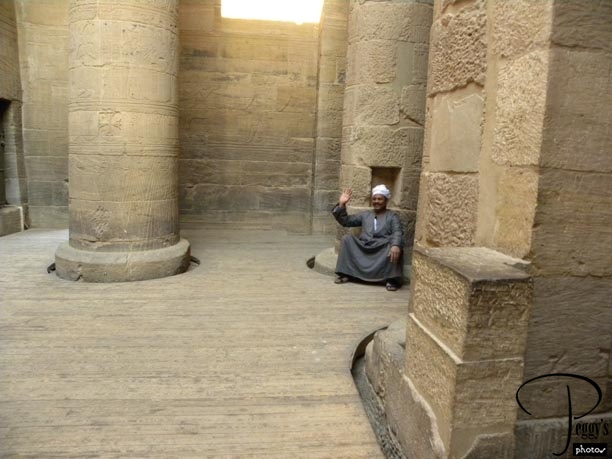
Someone else was having him pose so I got a free photo.

Inside the Second Pylon
Figures on the Walls
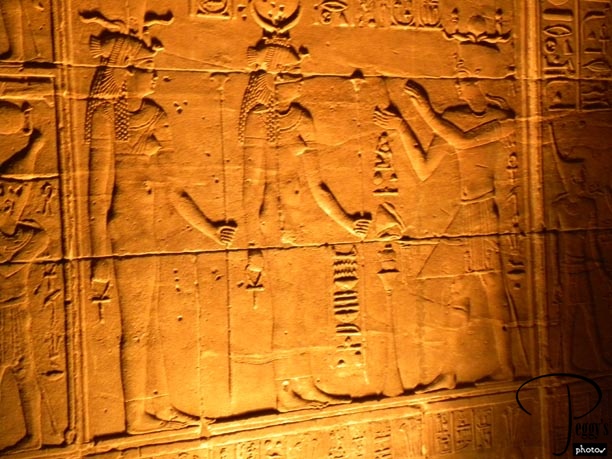

Figures on the Walls
Hieroglyphics
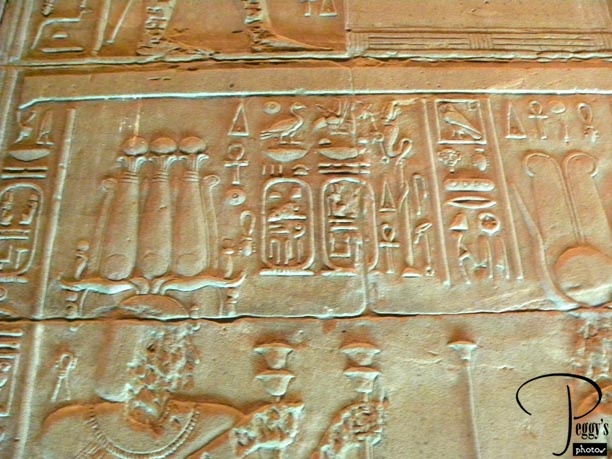

Hieroglyphics
More Hieroglyphics


More Hieroglyphics
More Figures and Hieroglyphics
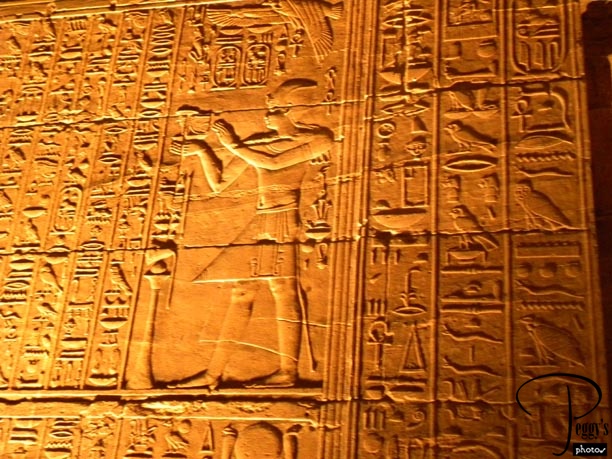

More Figures and Hieroglyphics
The Temple of Augustus and the Roman Gate
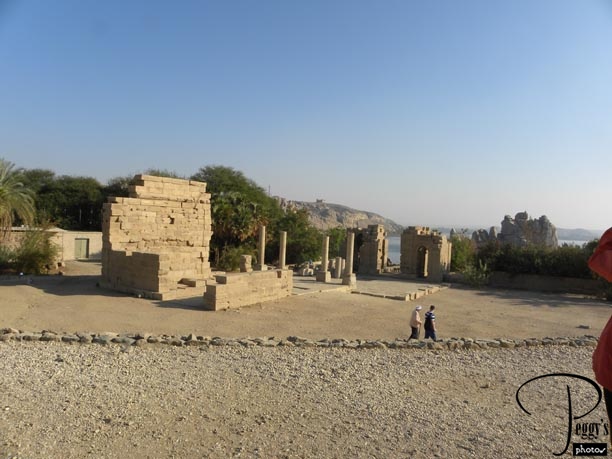
At the back of the second pylon, the Temple of Augustus and the Roman Gate. Egypt became part of the Roman Empire in 30 BC, ending the reign of the Ptolemic Dynasty (Cleopatra reigned under the Ptolemic Dynasty from 51–30 BC).

The Temple of Augustus and the Roman Gate
More Hieroglyphics
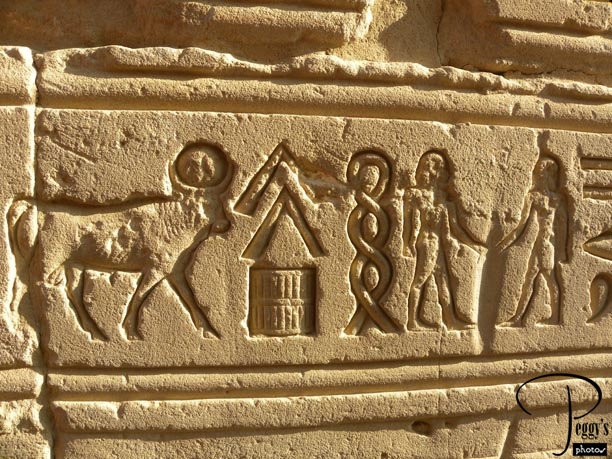
These were on one of the back walls of the second pylon.

More Hieroglyphics
The Christian Era
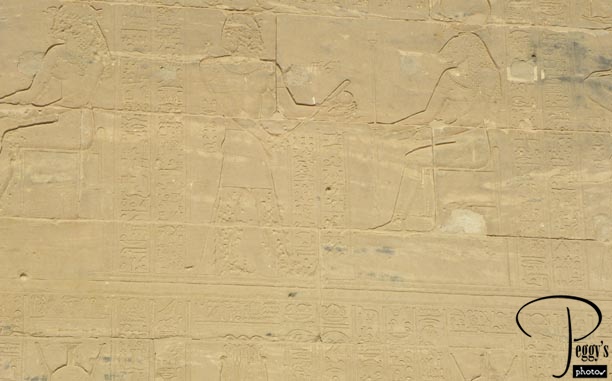
If I remember correctly, this was the condition of the wall opposite the wall in the last photo. The Temple of Isis at Philae was the last Egyptian pagan temple. It was closed down in the 6th century AD by the Byzantine emperor Justinian and turned into a Christian Church dedicated to the Virgin Mary. Some of the figures and hieroglyphics were defaced by the Christians. In the 7th century, the church was closed down by the Muslim invaders.

The Christian Era
The Kiosk of Trajan
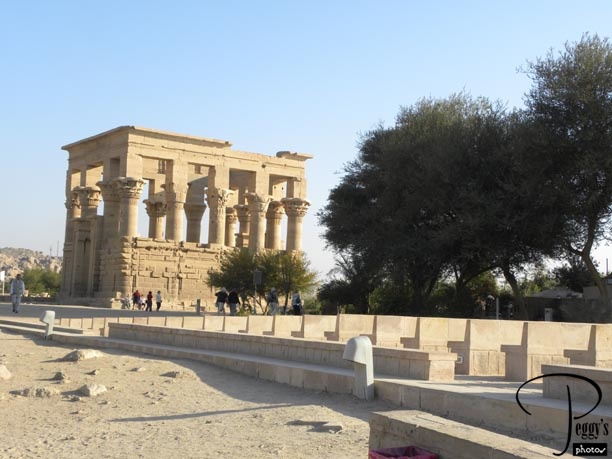
The Kiosk of Trajan rebuilt by the Roman emperor Trajan. It was where a sacred barge carrying a statue of Isis landed during an annual procession.

The Kiosk of Trajan
Closer-up of the Kiosk of Trajan
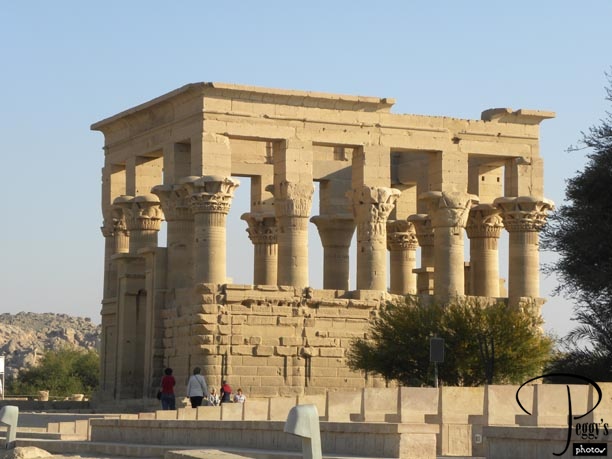

Closer-up of the Kiosk of Trajan
Close-up of Columns
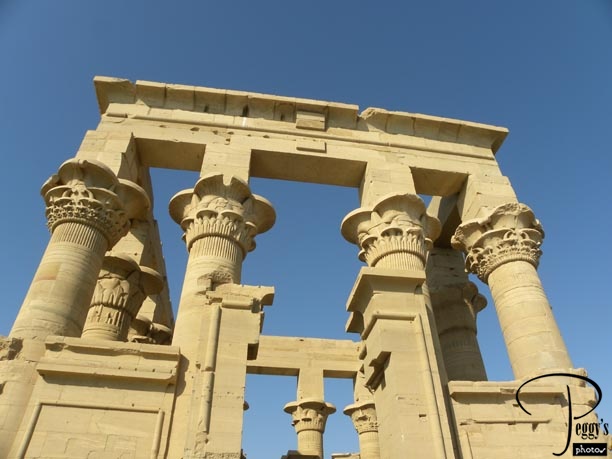
The Kiosk of Trajan has 14 massive columms, with their tops representing palm branches and lotus flowers.

Close-up of Columns
Another Close-up
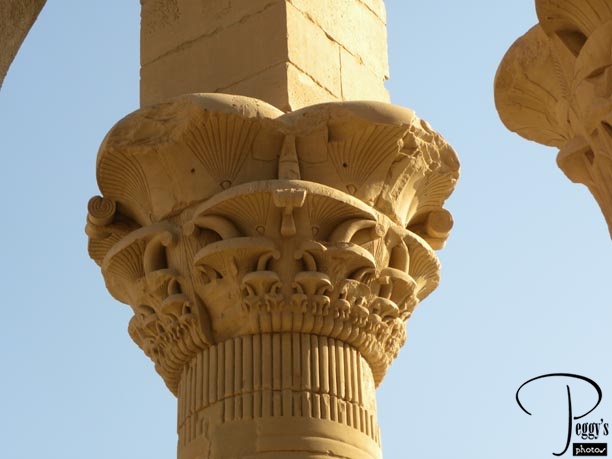

Another Close-up
Inside the Kiosk
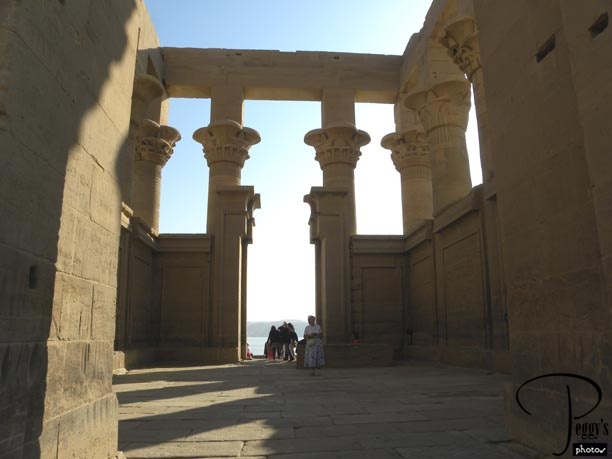

Inside the Kiosk
The View from Trajan’s Kiosk
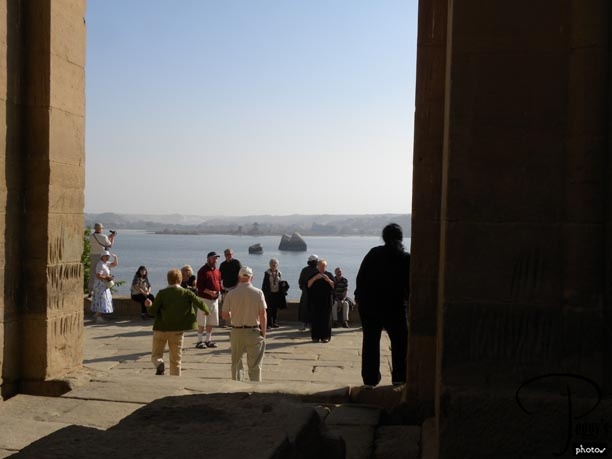
We have to assume that there was a similar view from Trajan’s Kiosk when the temple was on the island of Philae.

The View from Trajan’s Kiosk
Going Back to Our Boat to Leave the Island
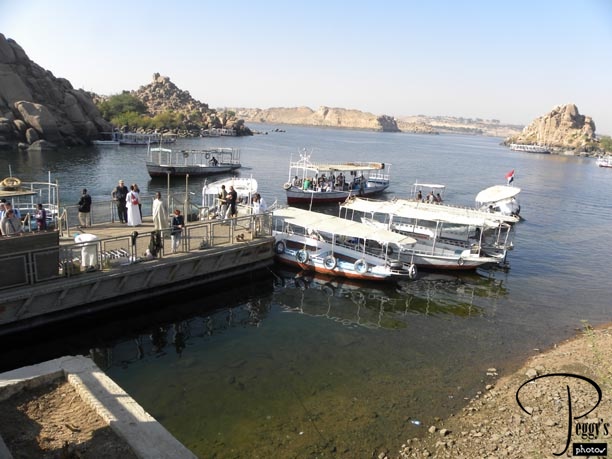

Going Back to Our Boat to Leave the Island
Leaving the Island
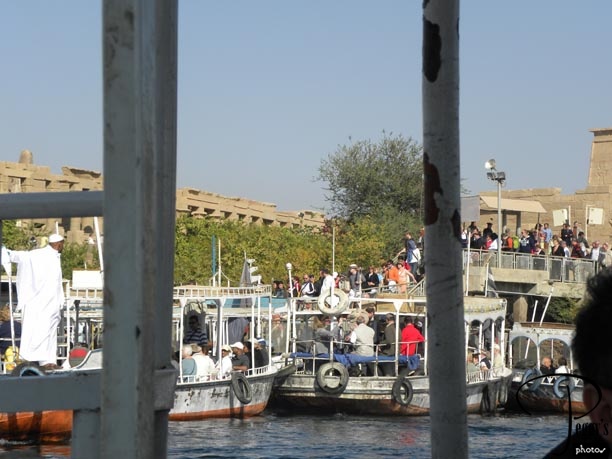
We were one of the first tour groups visiting the Temple of Philae this morning, getting a first start due to our early flight. However, as time went on, more and more tourists arrived: hordes of tourists. And this we encountered at almost every site we visited in Egypt. I was surprised as to how popular a tourist destination Egypt was. Amro told us that there are three times more tourists coming to Egypt from Russia than from the United States, and there were thousands of American tourists.

Leaving the Island
Some Local Color
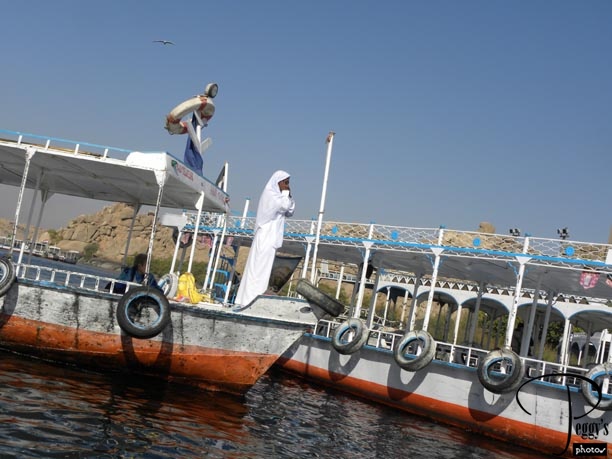

Some Local Color
The Kiosk of Trajan Seen from the Sea
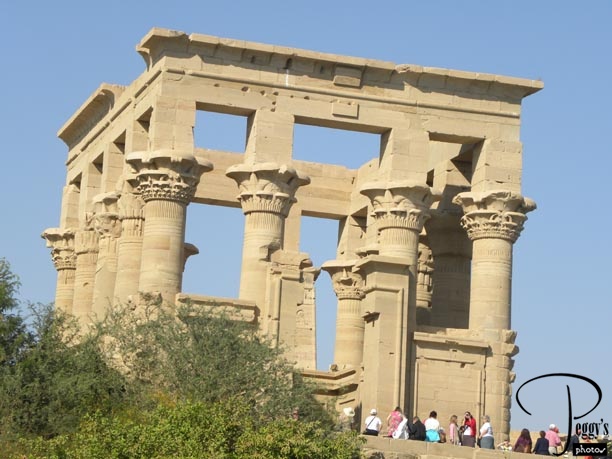

The Kiosk of Trajan Seen from the Sea
Back to the Egyptian Shopping Gauntlet
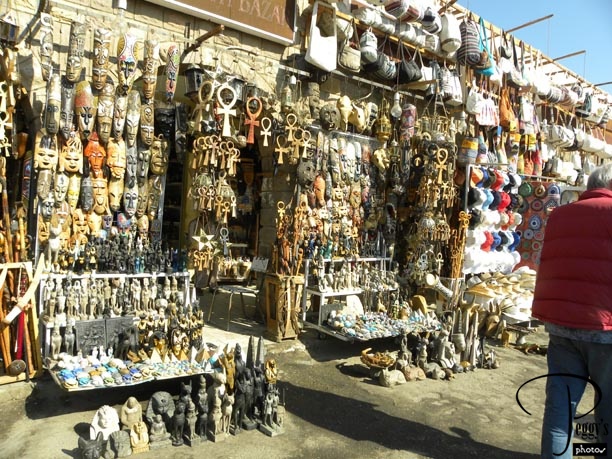
Eyes straight ahead, walk fast.

Back to the Egyptian Shopping Gauntlet
More to Buy
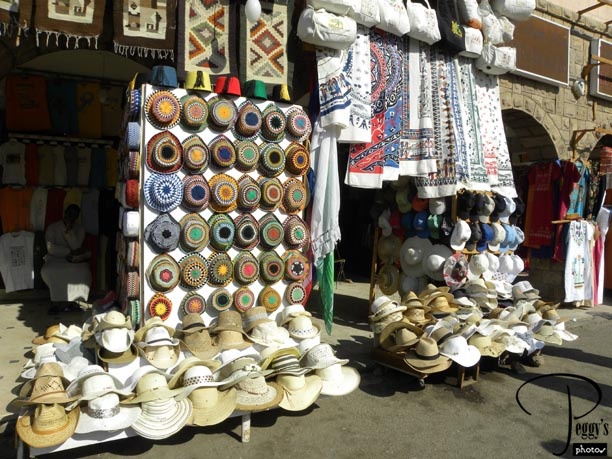

More to Buy
And More
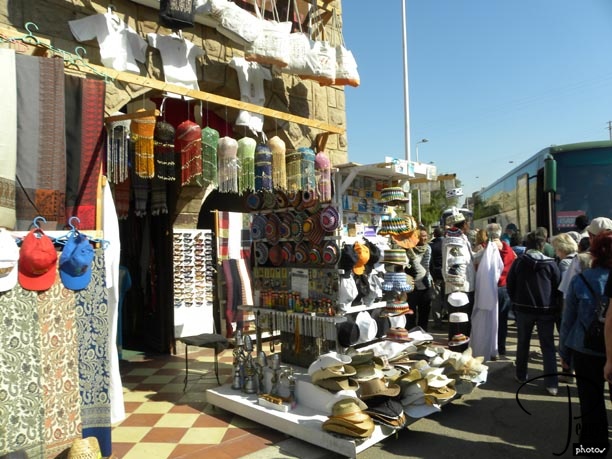

And More
Back on the Bus—Aswan
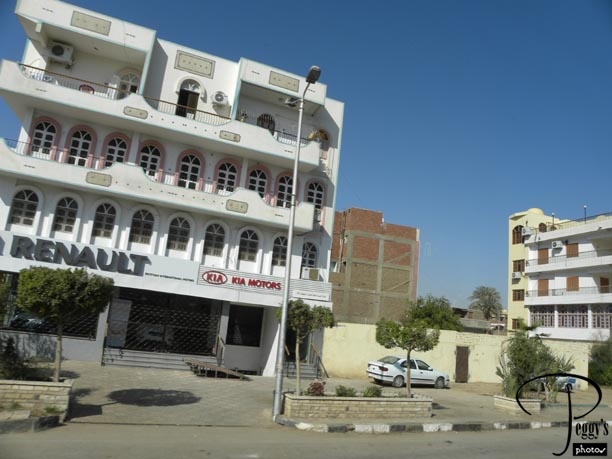
There were a number of very nice, modern buildings in Aswan. I included this off–center photo to have you look at the brick building in the middle. This is how many buildings in Egypt are built: just bricks with no windows. The windows and terraces are added later.

Back on the Bus—Aswan
Another Modern Building
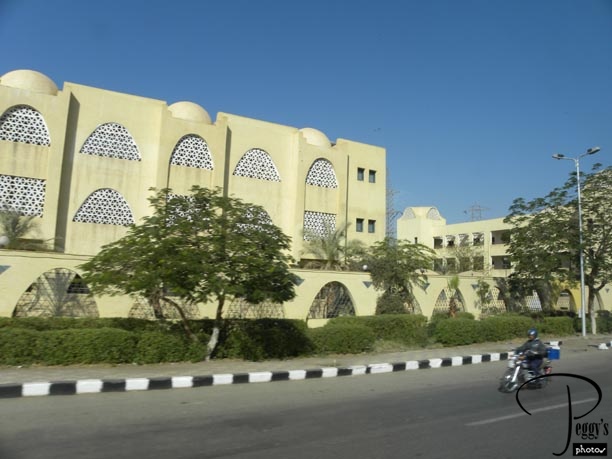

Another Modern Building
And Another
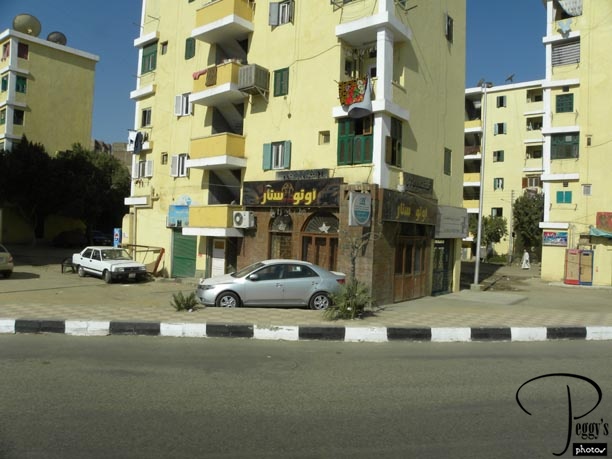

And Another
Fatimid Cemetery
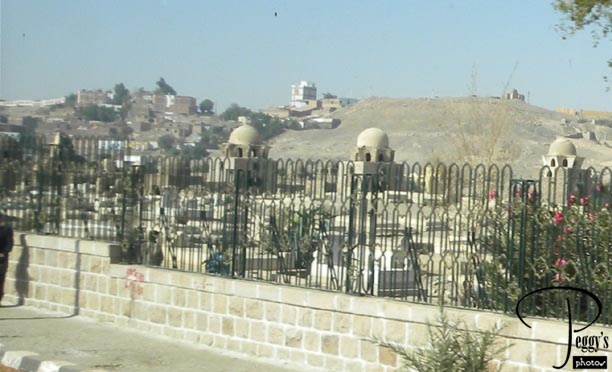
I took this photo from our bus. I wish we had stopped at it. The cemetery contains several hundred mudbrick Islamic tombs built between the 8th and 12th centuries. I think they make a great photo.

Fatimid Cemetery
The Unfinished Obelisk
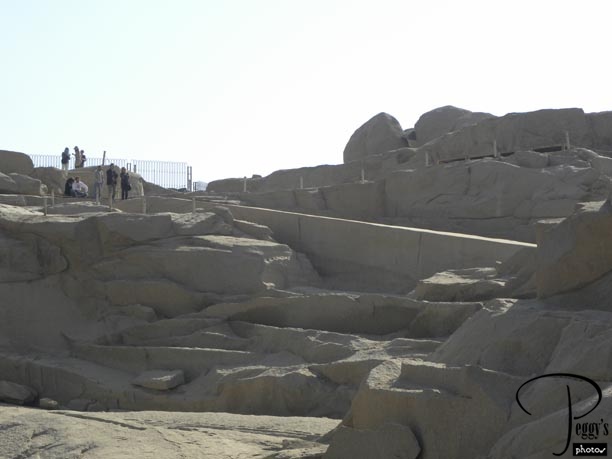
Look at the middle of the photo. This is an ancient quarry from the New Kingdom (1550–1069 BC). Obelisks were carved out of the quarry rock and then transported to their new homes. This obelisk was about ¾ finished before a flaw was seen in it, so it was left where it was being worked on. If it had been finished, it would have stood 41 feet high.

The Unfinished Obelisk
A Coptic Christian Church

A very large Coptic Christian church that we passed by.

A Coptic Christian Church
The Corniche
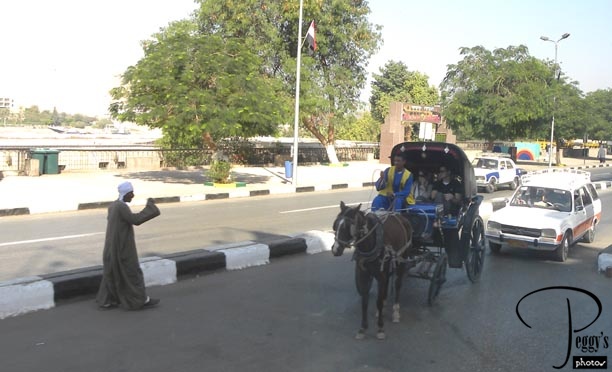
We are now on our way to our Nile River boat along the Corniche (the river bank boardwalk). Many tourist horse carriages ply this route. There are many more monuments, temples, tombs, etc., to view in Aswan. You could spend some time here visiting them all, plus a visit to the souk, etc. Aswan is also from where you take tours to Abu Simbel.

The Corniche
Scene Along the Corniche
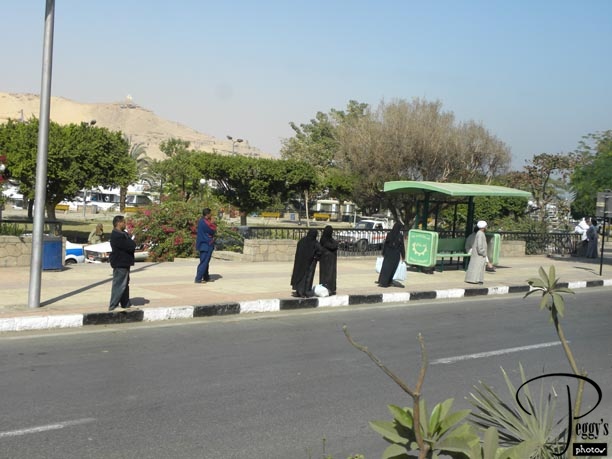

Scene Along the Corniche
Nile River Boats
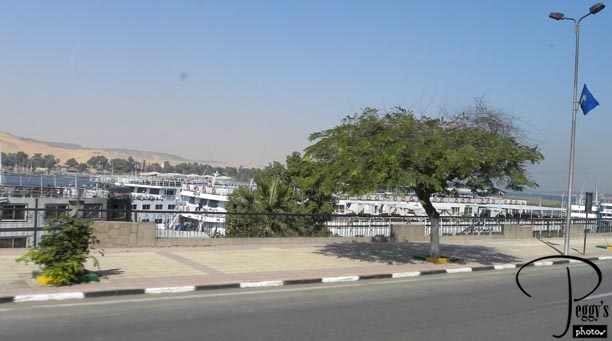
There are about 300 boats taking tourists on Nile River cruises. They line up at various places along the Nile, sometimes 7 or more across.

Nile River Boats
Our Boat, the Queen of Hansa
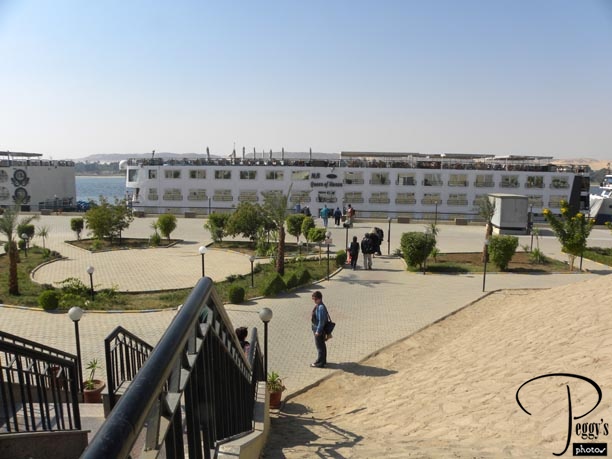
The Nile boats are in all categories from simple to luxurious. I think our was about in the middle range, noted, later, when crossing over from boat to boat to get to the piers. We were to be on the Queen of Hansa for the next three nights, cruising up to Luxor.

Our Boat, the Queen of Hansa
Close-up of the Queen of Hansa
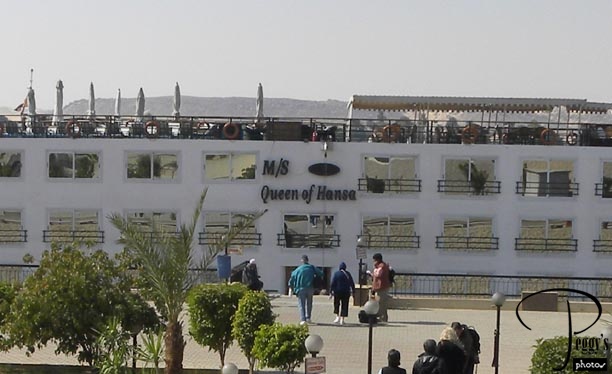
From the piers, there were stairs, sometimes with rails and sometimes without. The gangplanks from the docks were a heavy, nonmoving board, fitting about 1 ½ persons width, with only posts and rope on its sides. Don’t look down! When one of my tourmates, Burt, saw me stopping to evaluate my walking down the nonrailed stairs and then across the gangplanks, he offered to lend me his hand for the stairs and the crossings. I am so thankful to him. Good balance is not one of my attributes. I am convinced that my late husband sent him along on this trip.

Close-up of the Queen of Hansa
Tea Time
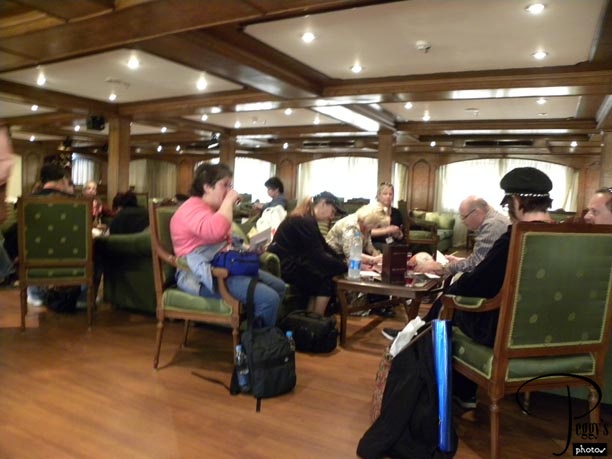
We had tea in the ship’s lounge before going to our cabins.

Tea Time
Food
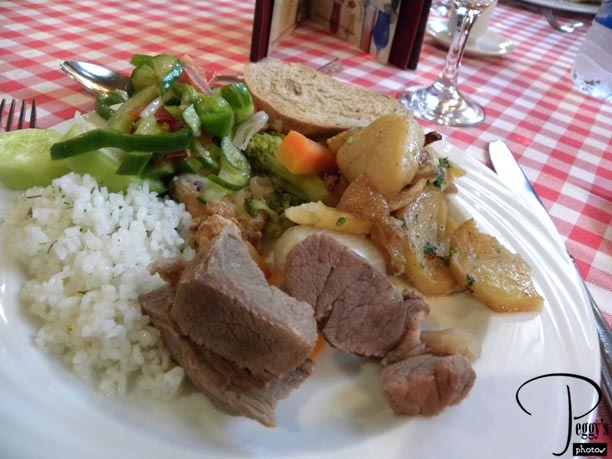
All our meals, breakfast, lunch, and dinner, were served buffet style. There was plenty of eat, some of it very good and some of it just so so, depending on your taste buds. I didn’t like the beef, unless it was cooked almost Mexican fajita style (Egyptian–Mexican fusion food?). On the ship, it was okay to eat the salads. Off the ship, we were told not to as raw food could make us ill. Only bottled water was safe to drink and you used bottled water to brush your teeth.

Food
The Desserts
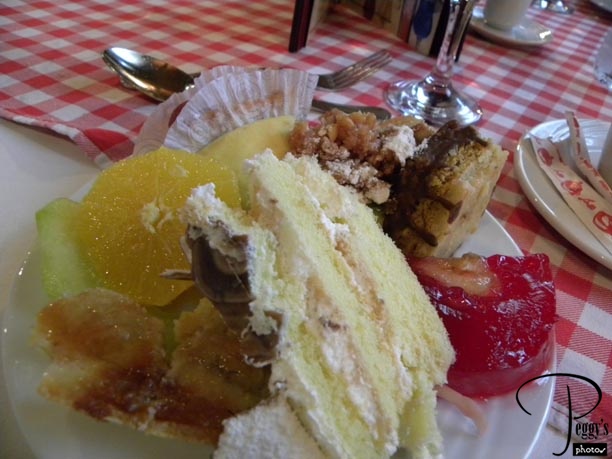
The desserts were heavenly, most Egyptian specialties, and a large choice of them. I wasn’t the only one adding dessert upon dessert on my plate.

The Desserts
The Top Deck
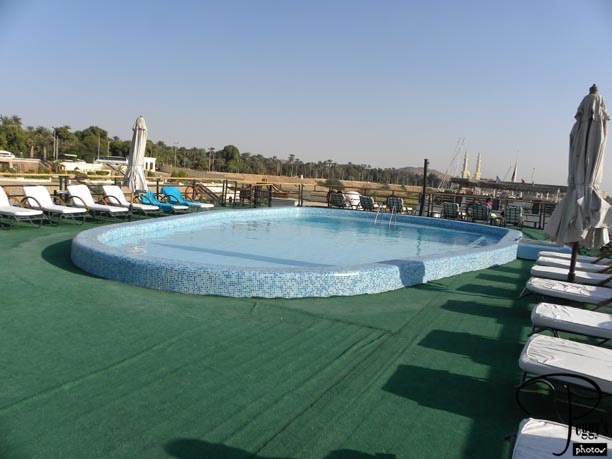
The top deck of the Queen of Hansa, at the top of about three stairwells. We got a lot of exercise on this ship. Too chilly for swimming and you needed a coat up here. But lie out on a lounge chair and watch the Nile go by and it was greatly relaxing. I have put my Nile Cruise photos on three slide shows: Go to Slide Shows, Nile River Cruise. There are many photos, but you do get to take the cruise along with me. If you do take a Nile cruise, in order to see what many of my photos show, you will need to take along binoculars or a camera with a good zoom lens (my choice). We weren’t as close to the shores as my photos make out that we were.
We stopped at Kom Ombo the first day of our Nile Cruise.

The Top Deck
Temple at Kom Ombo
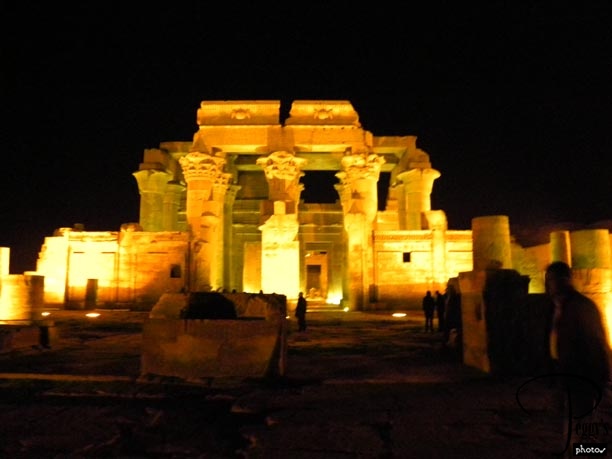
Our boat left Aswan late, so we landed in Kom Ombo after dark. However, the temple was only a short walk from where our boat docked.
The Temple of Kom Ombo is a Greco–Roman temple begun by Ptolemy XII Philometer in the 2nd century BC and was completed by Ptolemy XII Nios Dionysis during the 1st century BC, with the Roman emperor Augustus adding the entrance pylon around 30 BC. The temple is symmetrical, having two entrances, halls, and sanctuaries, and is dedicated to two gods: to the falcon god Horus the Elder and to Sobek, the local crocodile god. The temple is also called The House of the Crocodile and the Castle of the Falcon.

Temple at Kom Ombo
Close-up of the Temple of Kom Ombo
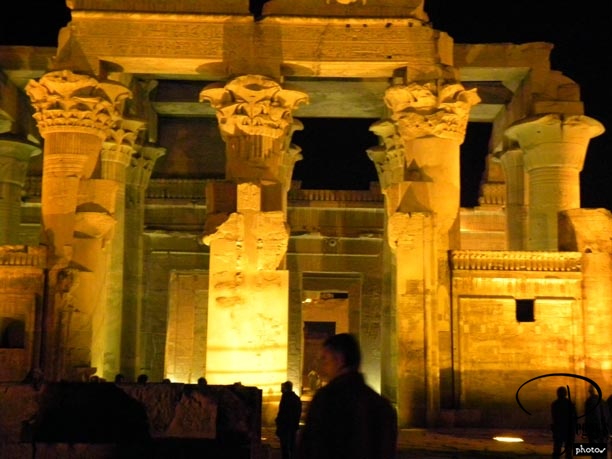

Close-up of the Temple of Kom Ombo
The Right Side, Dedicated to Sobek, the Local Crocodile God
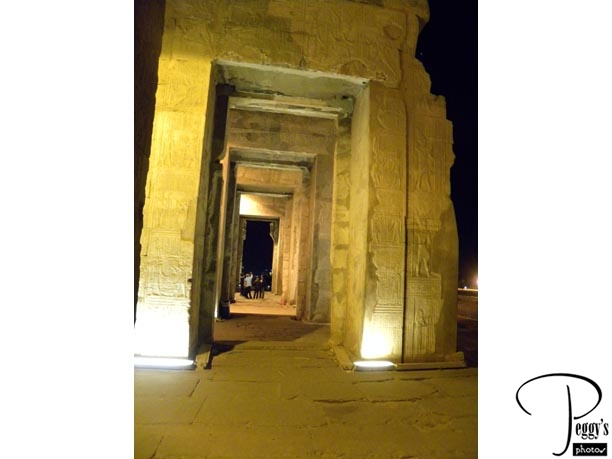

The Right Side, Dedicated to Sobek, the Local Crocodile God
The Left Side, Dedicated to Horis the Elder
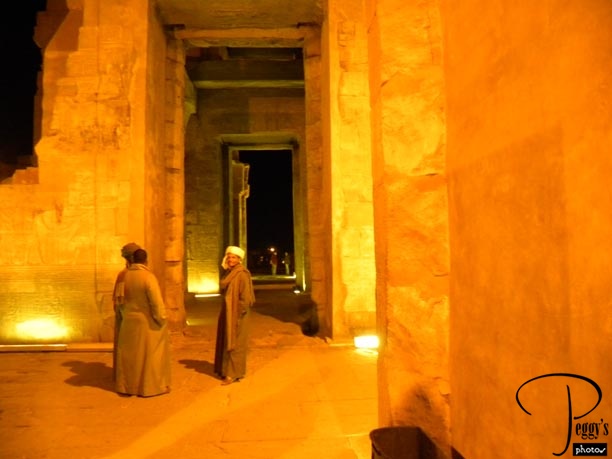

The Left Side, Dedicated to Horis the Elder
Welcoming Bird
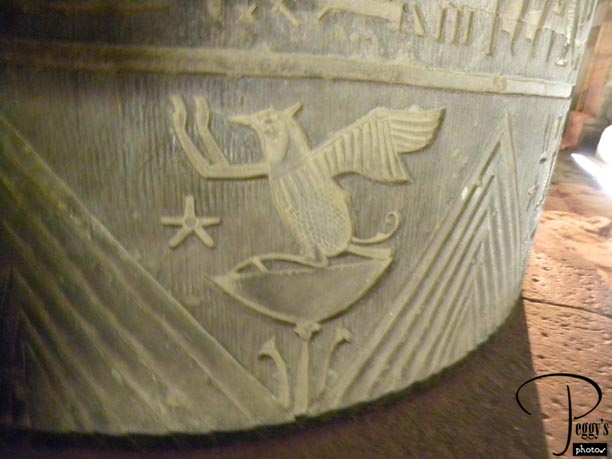
If this bird figure was present inside a temple, it meant that all pilgrims could enter the temple. If it didn’t appear, only priests could enter.

Welcoming Bird
Hieroglyphics
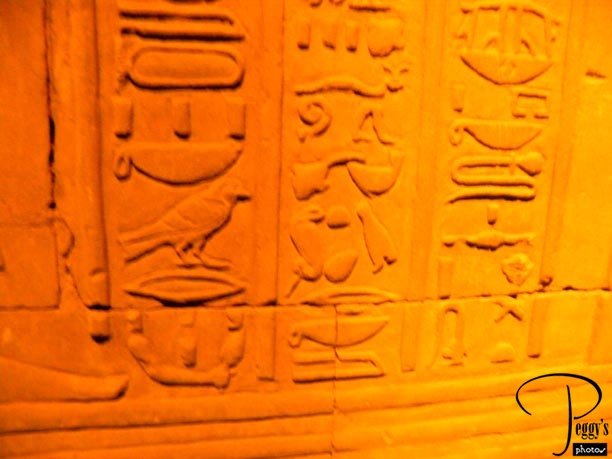

Hieroglyphics
Figures and Hieroglyphics
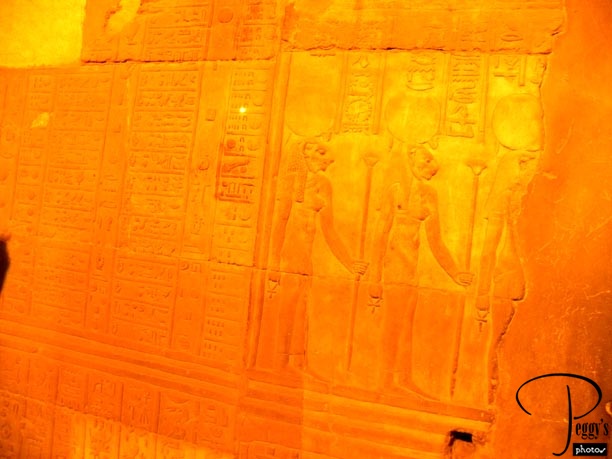

Figures and Hieroglyphics
A Wall
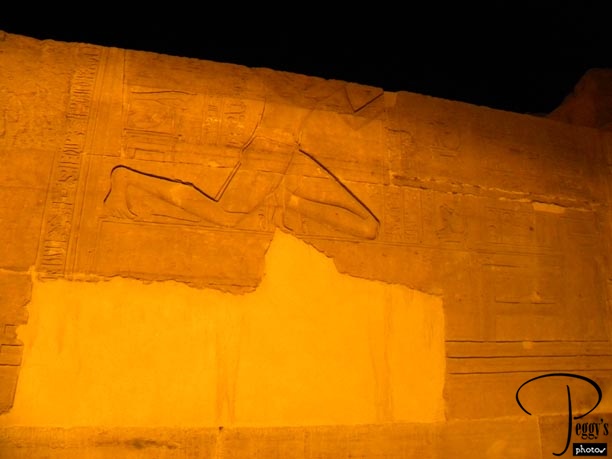
Here, the top coating of the walls has peeled off or was removed. The temple later became a Coptic Christian church and they defaced many of the reliefs.

A Wall
More Figures


More Figures
Another Figure
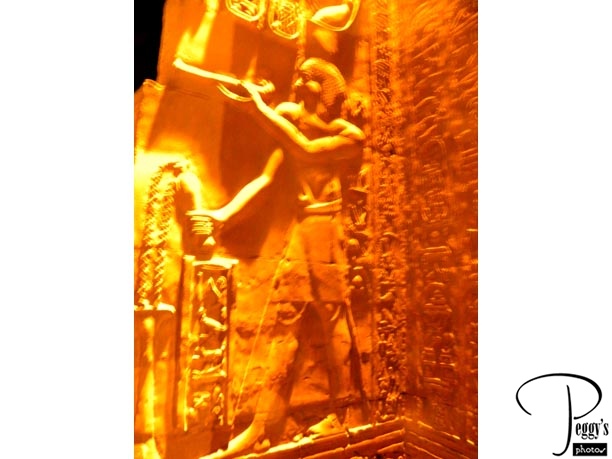

Another Figure
Massive Columns
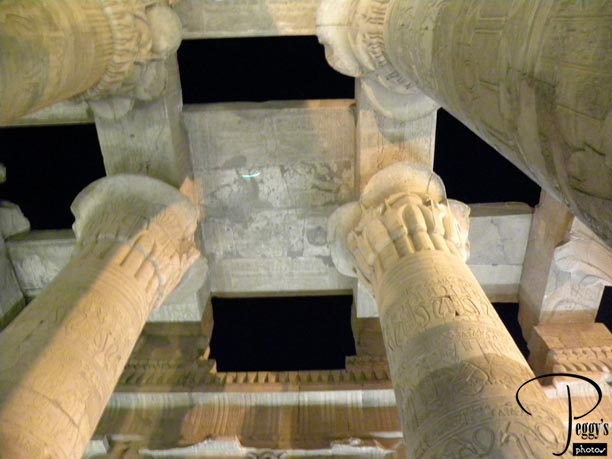
The columns tops represent the lotus or lily of Upper Egypt or the papyrus of the Nile Delta.

Massive Columns
Between the Columns
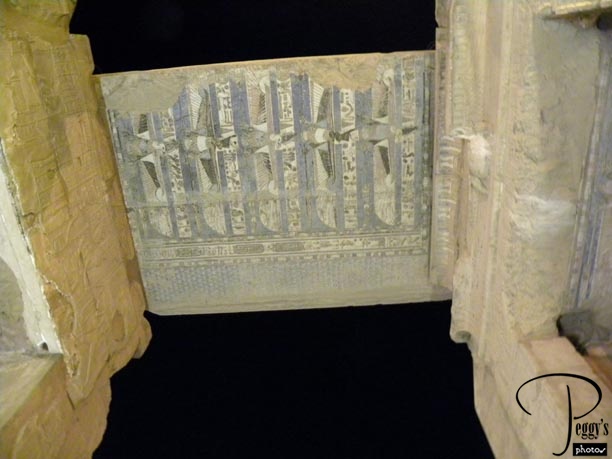
Here, some of the original paint still remains.

Between the Columns
Close-up of the Painted Area
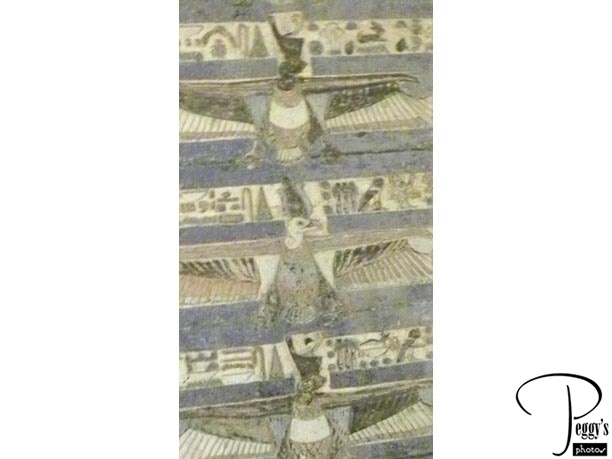

Close-up of the Painted Area
More of the Columns
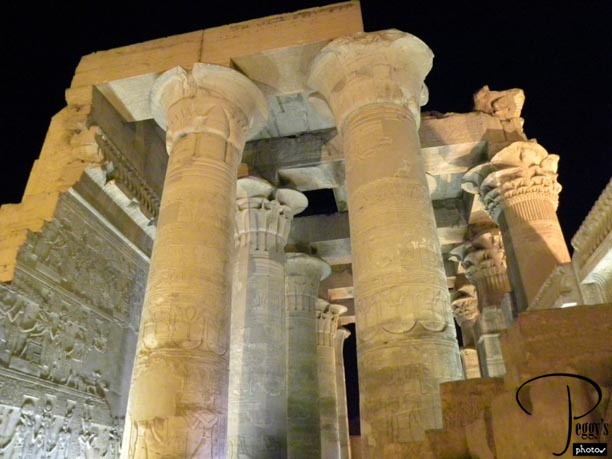

More of the Columns
View of the Temple of Kom Ombo from the Back
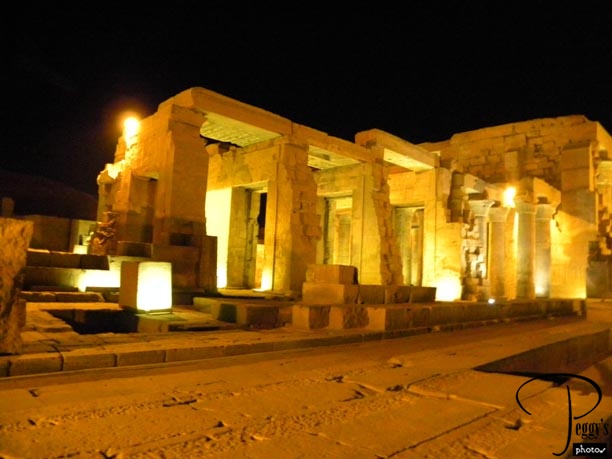

View of the Temple of Kom Ombo from the Back
View of the Temple of Kom Ombo from the Side
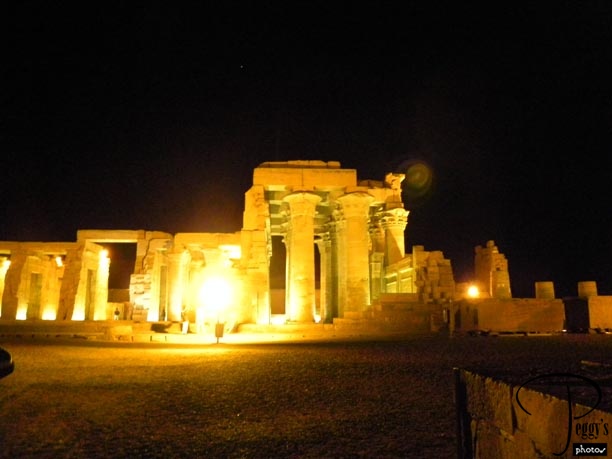
In this photo, you can make out part of the mud brick wall enclosing the temple. The temple itself was built of silsila.
There is also a structure called the Hathor House here that contains 40 crocodile mummies. We didn’t see the mummies.

View of the Temple of Kom Ombo from the Side
Back to the Ship for Dinner
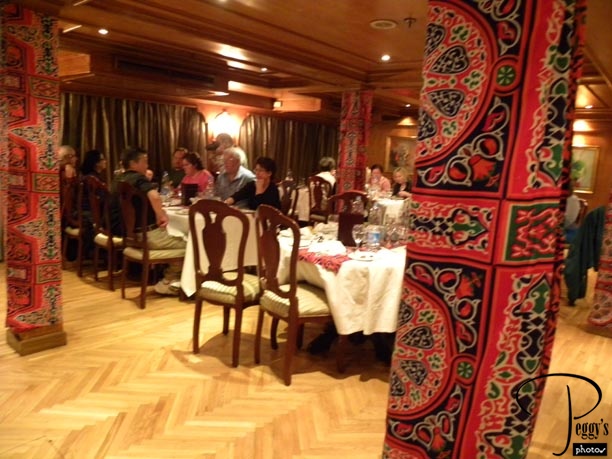
Tonight was Egyptian night and everyone was to dress up in Egyptian dress, but this did not go over well. Maybe we all were just too tired from our very long day. The waiters did wear jibabs—long cloaklike attire. We sailed overnight to Edfu.
